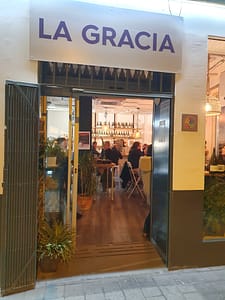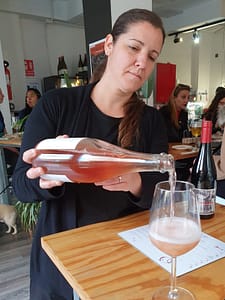La Gracia is a small and cozy natural wine bar that opened in 2020, when the pandemic was at its height. It’s found in Murcia capital, Spain, in one of the narrow streets behind the city hall and the cathedral in the Santa Eulalia district. They work with artisan producers of wine, cheese and also beer and other products. The owners are Esperanza Pérez Andreo and Cristina Ramos Berna. They have strong ties with local and regional producers from whom they buy directly.
I was there twice at the end of the year, including New Year’s Eve. We sat on the “terrace” (i.e. the plaza behind the first street) near midnight, and then inside the bar around noon. We chose from the cold and the warm tapas menues, and from the by-the-glass wine selection, that counts on around 30 references.
Among the small dishes we chose was a “cured” cheese selection. The first one was a young and fresh, but oh so tasty, cheese from Cartagena, then a 3-4 months cured goat’s cheese soaked in red wine, then a 9 months cured cheese from San Javier called ‘El Abuelo’ (the grandfather) and finally a wonderfully complex cheese from a mountain between Cartagena and Mazarrón. The watermelon marmelade was from coastal San Javier.
The wine list contains established and new natural wine stars from Murcia and elsewhere in Spain. We started with Las Madres 2020 (Punta de Flecha), a light skin-contact white from the Madrid area. The grape is malvar, and like many other wines from that variety it is low on acidity but rather textured. Amber coloured and slightly fizzy, it had a nice aroma of flowers and orange peel.
Viña Enebro is rather well-known in Spanish natural wine circles, and you can read about a visit in Bullas here. El Yesar 2020 is a white wine made from the red grape forcallat. Hence it has a little blush of red. It’s round and tasty, and the aroma includes traces of citrus (clementine) and herbs.
At the second day I asked for whatever white wine and was served Doble Plaer 2020 from Vinyes Singulars (with collaboration from Toni Osorio) It turned to be a wonderful wine with a phenomenal acidity, almost electric. It has a good body too. Light orange in colour, and somewhat cloudy, with an aroma of citrus peel (lemon) and flowers over black tea. Long aftertaste where the citric notes linger. The grapes are malvasía de Sitges and parellada.
The two first reds were revelations from the Murcia region. Negrete 2021 from Negrete Blue is a monastrell/garnacha tintorera from no less than 1.373 meters of altitude in the Bullas denomination. It was a fresh and juicy, berry-dominated, young wine, with blackberry and blueberry in front.
Tinaha 2020 comes from the bodega of the same name. It’s found between Molino de Segura and Jumilla to the north of the regional capital. As the name implies they believe in ageing in clay (tinajas). The varieties are a local field blend, and so monastrell should be among the suspects. The wine had red berry notes, but was more dominated by a clay minerality with flowers, and had a juicy taste with a long aftertaste, and especially for the region, good acidity.
We tasted two reds from Castilla. Felipe el Caminero 2021 (Inma Badillo) is a fresh tempranillo/ juan garcía/bruñal blend from Arribes del Duero, close to the Portuguese border (provinces Zamora and Salamanca). It’s a pure, very juicy and fruity wine with lots of berry character. La Payana 2020 (Cható Gañán) is completely different. Made from garnacha on granite soil in the Sierra de Gredos, it has a more serious air to it. It has some of the etheral character often associated with the Gredos garnachas, and some of the minerality behind the red fruits. The oak shows delicately on the palate.
Since I was back on New Year’s Eve I took the opportunity to round off with a sparkling wine. The choice fell on En Moviment A 2020 (Bàrbara Forés) from Terra Alta, Catalunya, made from the local morenillo grape. The sparkling rosé smells of peach and grapefruit. There is an acidic attack in the mouth, the wine is slim in the middle, but the citrus acidity strikes back and gives it a lift towards the end.
Leave a Comment

















































